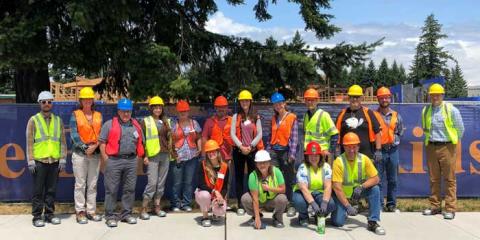High school teachers tour mass timber building
July 25, 2019
A bolt in a bus tire, an educational sawmill stolen, and finding an alternative to steel-toed shoes – these are just a few unexpected occurrences that make organizing a tour eventful. But if there’s a group that thrives on being flexible and adaptable in their jobs, it’s high school teachers. In June, OFRI and the USDA Forest Service sponsored the Sustainable Forestry and Mass Timber Teacher Tour for high school teachers. The focus was on hearing from a diverse group of professionals in the architecture, construction and wood products manufacturing fields who are working together to design and build with wood in innovative ways. This summer tour also offered a welcome opportunity for teachers to spend time learning from each other and some community college partners.
The tour started at the World Forestry Center, which currently has a display on mass timber called The Future of Tall. Participants heard from TallWood Design Institute, a joint program between Oregon State University and the University of Oregon. This provided an opportunity for discussion on new and emerging workforce opportunities for students.
The highlight was visiting a mass timber project that was in the process of being built by Skanska, a world-renowned construction company. Skanska graciously hosted our group and donned them in safety gear, including loud and clanging steel-toed shoe covers. It was a great fit to visit an elementary and middle school complex being built with sustainability and green building in mind, including mass timber products.
Mass timber products, which include glue-laminated timber (glulam), cross-laminated timber (CLT) and mass plywood panels (MPP), create new jobs and a positive economic impact. With innovations in wood technologies, architects and engineers are now choosing wood for more building applications, including mid-rise and even high-rise structures. You can see many of these buildings around the Portland area, including the first tall-wood building in Oregon, Albina Yard. However, there isn’t much parking for a bus in that neighborhood, so the teachers on tour just got to check out pictures in the Forest to Frame publication.
The first day of the tour concluded at Multnomah Falls, including time to hike and dine in the historic lodge. Teachers enjoyed this time together, along with discussions around forest fires, recreation and the history of using wood products in Oregon. Luckily it was a beautiful summer night to enjoy the falls, an Oregon treasure, because a bolt had flattened our bus tire.
The second day of the tour was hosted by our college partners, Mt. Hood Community College Natural Resources Technology program. Teachers received resources, curricula and hands-on experience related to teaching about state-of-the-art wood products, the role of carbon in forests, urban and rural forest management, and more.
The college’s Natural Resources Technology program has a portable sawmill for teaching students, who get to process a few urban trees each term. Unfortunately the sawmill was stolen just weeks before our scheduled tour. Luckily, the Wood-Mizer Company came to the rescue and brought a sawmill to the college for demonstration. Teachers enjoyed watching the process and thinking about how the applications of this small-scale mill applies to the larger manufacturing of wood products.
As the tour and our time together concluded, we asked teachers to complete evaluations. One teacher provided us with this feedback: “I loved learning about the mass timber technology and thinking about how it applies to my students and classroom. I plan to expose my students to the variety of mass timber products and technologies. They can see some of the upcoming career opportunities in forestry/engineering/construction/architecture.”
Why does OFRI invest in these teacher tours? OFRI has been partnering with school districts and the Oregon Department of Education to advance a statewide Career and Technical Education (CTE) Program of Study for Natural Resources. OFRI’s role has been to provide professional development opportunities for teachers to learn about current industry practices and career opportunities for their students. In addition, the high schools need to align their CTE programs with college and trade school partners. This tour provided an opportunity for teachers to meet many of those needs. One teacher stated about the tour, “OFRI provides current and meaningful professional development, along with lessons that engage students and meet standards.”
For the forest,
Julie Woodward
Senior Manager
Forestry Education
